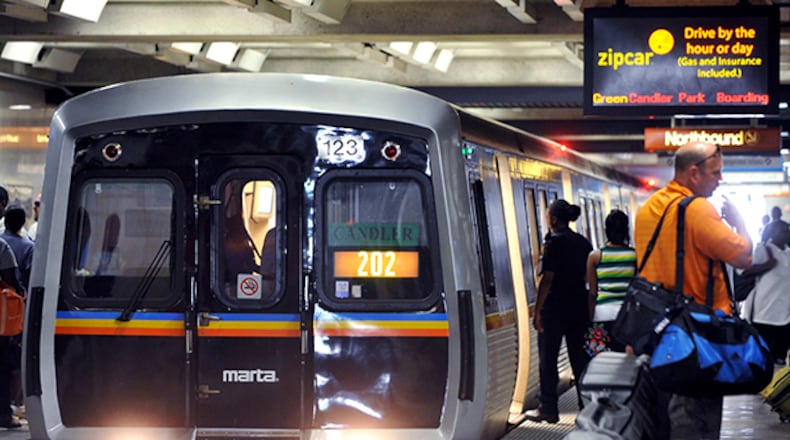Hardly anyone noticed when the knife pierced his heart.
Damilola Azuana was a panhandler, 41. Police say he was killed in January on a MARTA train pulling into the Avondale station by a man who taunted him, told him to get a job and wondered aloud if he had a vagina.
Sordid as the case might be, there was no press release from MARTA, no immediate news coverage, no collective outrage and mourning.
Such cases can fade into the shifting backdrop of metro Atlanta.
But, in truth, Azuana's death counts as the fourth homicide investigated by MARTA police in a span of four months, a highly unusual spate that renews an old question: How safe is MARTA really?
'Isolated incidents'
MARTA and its advocates, who’ve worked for years to combat the system’s sometimes sour reputation, assure the killings are “isolated incidents.” In response to questions, MARTA said its police are “vigilant” and have filed murder charges and made arrests in all recent homicides.
In spite of the killings, MARTA is still “one of the safest transit systems in the country,” the agency told The Atlanta Journal-Constitution.
MARTA crime data shows there were no homicides on the system’s property in the last four fiscal years. But this fiscal year, which ends in June, MARTA police have already worked four.
In addition to the Avondale homicide, a man was shot to death this month while boarding a bus at the College Park station.
Another man was shot and killed in November at the H.E. Holmes station, where less than a month earlier police found a dead man in the trunk of a car. He apparently had been killed elsewhere and left in the trunk in the parking lot.
These cases were noticed only long enough to play well in one news cycle, then vanished.
What the data says:
Comprehensive crime data for America’s transit systems is scarce. The systems aren’t required to report all crimes to the Federal Transit Administration, the FTA told The Atlanta Journal-Constitution.
For comparison, the newspaper obtained statistics from San Francisco’s Bay Area Transit System, Washington DC’s Metro and the Massachusetts Bay Transportation Authority. Like MARTA, each is a large system with rail in a major metro area.
In 2015, for instance, among the four transit systems, only the Massachusetts system had a lower rate of violent crime. MARTA’s rate was about 30 per every 100,000 average daily riders the system has, the same as DC’s, while Massachusetts’ was 23. The San Francisco system, whose rider numbers are most comparable to MARTA, had a rate of 44, the AJC found.
MARTA counts crimes by fiscal year, while the others use calendar years. The systems’ ridership rates are different, but the AJC’s analysis calculated the crime rate with ridership in mind to keep them on a level playing field. MARTA’s crime numbers include crimes committed onboard their rail cars, buses, and in their stations or parking lots.
MARTA’s data shows the system saw 131 violent crimes (homicides, rapes, robberies and assaults) in fiscal 2015, including 61 robberies, 68 aggravated assaults and two rapes. In fiscal 2016 robberies fell to 52, while aggravated assaults rose to 95.
As is typical for MARTA, most crimes took place among rail riders, while a still-sizable number were classified as relating to buses and parking lots.
MARTA’s overall crime was down 13 percent in 2016 from the previous year.
The system's increase in homicides appears comparable to similar upticks in the metro area, such as in the city of Atlanta and DeKalb County.
For customers: Fearing crime
MARTA boasts more than 10,000 surveillance cameras (several of which reportedly captured the train stabbing) and the free See & Say smart phone app. Customers can discreetly contact MARTA police with the app, or with emergency phones placed around MARTA locations.
“Although MARTA Police can’t be everywhere, the officers are vigilant about looking out for suspicious behavior throughout the system and rely on MARTA customers to be our eyes and ears,” agency spokeswoman Alisa Jackson said.
But all the efforts to keep the system safe don’t mean as much if customers don’t actually feel secure.
Alicia Boyd, an accountant who works for CNN, stood in the breeze at the Avondale station recently listening to the story of Azuana’s stabbing.
Her mind seemed to reel as she heard how he lay bleeding on the same platform Boyd uses to catch her train. How all the police say Azuana did was ask for money. How he was stabbed at 8:15 p.m. on a Tuesday, not in the middle of the night.
Boyd’s eyes grew wide. She moaned in sadness.
“That’s scary,” she said.
Lee Biola, president of the local Citizens for Progressive Transit group, knows it can be difficult news to take.
“It’s very hard when people are faced with an actual murder to look at that bigger picture,” he said.
But the big picture, he pointed out, is that the hoards of commuters who use MARTA could also face peril driving.
Dozens of people might die on I-285 alone in a given year, and Georgia traffic deaths are on the rise.
“Even if the people on your train are not that stable, at least they aren’t behind the wheel of a car,” Biola said. “Cars can kill even when good people are driving.”
And crime can happen anywhere where people gather, he added.
And, accepting crime
After the initial shock of the homicides, many riders appear comfortable with an attitude similar to Biola’s, content to keep riding so long as “isolated incidents” stay isolated enough.
That was evident on a recent afternoon at the Avondale station.
A man urinated on a concrete column next to the escalator where Damilola Azuana bled from the wound in his heart.
Almost no one noticed.
People looked straight ahead, headphones plugged in, and silently awaited the train.
Tay Davis, a young man who said he’s been taking MARTA his whole life, hadn’t heard about the recent homicides.
“That doesn’t make me feel good,” he said.
The westbound was approaching as he explained how he’d never seen any such violence on the train and always tried to just mind his business.
When the train stopped, Davis didn’t hesitate.
He got on.
AJC Data Specialist Jennifer Peebles contributed to this report.
About the Author
Keep Reading
The Latest
Featured





